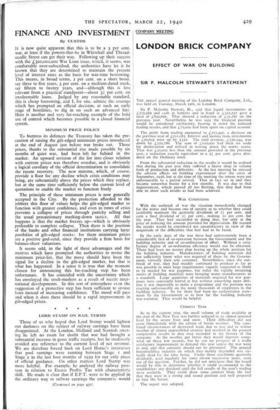FINANCE AND INVESTMENT
By CUSTOS IT is now quite apparent that this is to be a 3 per cent. war, at least if the powers-that-be in Whitehall and Thread- needle Street can get their way. Following up their success with the £300,000,000 War Loan issue, which, it seems, was comfortably over-subscribed, the authorities have let it be known that they are determined to maintain the present level of interest rates as the basis for war-time borrowing. This means, in broad terms, 2 per cent. on a short bond, say three to five years, 3 per cent. on a medium-dated stock, say fifteen to twenty years, and—although this is less relevant from a practical standpoint—about 3.-1 per cent. on irredeemable loans. Judged by any reasonable standard, this is cheap borrowing, and I, for one, admire the courage which has prompted an official decision, at such an early stage of hostilities, to dig in on such an advanced line. Here is another and very far-reaching example of the bold use of control which becomes possible in a closed financial system.
MINIMUM PRICE POLICY
To buttress its defences the Treasury has taken the pre- caution of raising the gilt-edged minimum prices introduced at the end of August just before war broke out. Those prices, thanks to the substantial rise made possible by six months of quiet war, had been left far behind in the market. An upward revision of the list into closet relation with current prices was therefore overdue, and is obviously a logical corollary of the official determination to consolidate the recent recovery. The new minima, which, of course, provide a floor for any decline which crisis conditions may bring, are substantially above the prices which they replace, but at the same time sufficiently below the current level of quotations to enable the market to function freely- The principle of these minimum prices is now generally accepted in the City. By the protection afforded to the jobbers this floor of values helps the gilt-edged market to function with greater confidence, and even in times of crisis prevents a collapse of prices through panicky selling and the usual precautionary marking-down tactics. All that happens is that the market freezes up—which is obviously preferable to complete collapse. Then there is the position of the banks and other financial institutions carrying large portfolios of gilt-edged stocks: for them minimum prices are a positive god-send, since they provide a firm basis for balance-sheet valuations.
It seems odd, in the light of these advantages and the motives which have prompted the authorities to revise the minimum price-list, that the move should have been the signal for a decline in the gilt-edged market, but that is what has happened. In a sense it is true that the moment chosen for announcing this far-reaching step has been unfortunate. It has coincided with the uncertainty which has enveloped the stock-markets as a result of recent inter- national developments. In this sort of atmosphere even the suggestion of a protective step has been sufficient to arouse fears instead of increasing confidence. The mood will pass and when it does there should be a rapid improvement in gilt-edged prices.






































 Previous page
Previous page